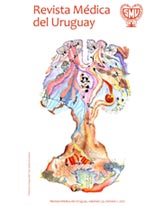Spontaneous ventilation test in ventilated patients
an assessment of fulfillment of protocol guidelines vs the analysis by the health team
Abstract
Introduction: Ideal duration of mechanical ventilation is a source of debate and uncertainty. Early weaning attempts result in failure and increased mortality rates, while a late discontinuation of ventilation increases the patients’ risks. The use of the spontaneous ventilation test is safe and results in a fair identification of patients who are ready for weaning. However, adherence to protocol guidelines varies and scientific evidence fails to be implemented in the clinical practice.
Objective: to analyze the interaction between mechanical ventilation discontinuation guidelines and medical assessment for the making of a decision.
Method: descriptive, prospective study which involved interviewing physicians in the Intensive Care Unit on their assessment of the patient’s condition to perform a spontaneous ventilation test. The physicians´ opinion was compared to the assessment carried out as per the Intensive Care Unit Protocol, in order to analyze agreements and discrepancies.
Results: 27 patients and 46 physicians were included in the study. Agreements represented 85.4% of opinions, although there were a few confusing elements confusing as to the medical decision to be made, both in terms of agreements and discrepancies, the most frequent of which was the patient’s level of consciousness.
Discussion and conclusions: assessing the level of consciousness of patients is essential in the daily practice of medicine, although not for the spontaneous ventilation test. It was included in almost one third of the responses obtained and delayed the performance of a spontaneous ventilation test. This fact needs to be considered both in the context of training instances and at the time of optimizing times for the spontaneous ventilation test and the discontinuation of mechanical ventilation.
References
(1) McConville JF, Kress JP. Weaning patients from the ventilator. N Engl J Med 2012; 367(23):2233-9.
(2) Frutos-Vivar F, Esteban A, Apezteguia C, González M, Arabi Y, Restrepo MI, et al. Outcome intubated patients after scheduled extubation. J Crit Care 2011; 26(5):502-9.
(3) Thille AW, Cortés-Puch I, Esteban A. Weaning from the ventilator and extubation in ICU. Curr Opin Crit Care 2013; 19(1):57-64.
(4) Fan E, Zakhary B, Amaral A, McCannon J, Girard TD, Morris PE, et al. Liberation from mechanical ventilation in criticall y ill adults: an official ATS/ACCP clinical practice guideline. Ann Am Thorac Soc 2017; 14(3):441-443.
(5) Burns SM, Earven S, Fisher C, Lewis R, Merrell P, Schubart JR, et al. Implementation of an institutional program to improve clinical and financial outcomes of mechanically ventilated patients: one-year out comes and lessons learned. Crit Care Med 2003; 31(12):2752-63.
(6) Duane TM, Riblet JL, Golay D, Cole FJ Jr, Weireter LJ Jr, Britt LD. Protocol-driven ventilator management in a trauma intensive care unit population. Arch Surg 2002; 137(11):1223-7.
(7) Krishnan JA, Moore D, Robeson C, Rand CS, Fessler HE. A prospective, controlled trial of a protocol-based strategy to discontinue mechanical ventilation. Am J Respir Crit Care Med 2004; 169(6):673-8.
(8) Santos C, Alzugaray P. Desvinculación de la ventilación mecánica. En: Biestro A, ed. CTI protocolos. Montevideo: Cuadrado, 2015:273-80.
(9) Lassen HC. A preliminary report on the 1952 epidemic of poliomyelitis in Copenhagen with special reference to the treatment of acute respiratory insufficiency. Lancet 1953; 1(6749):37-41.
(10) Bushnell LS, Pontoppidan H, Hedley-Whyte J, Bendixen HH. Efficiency of different types of ventilation in long-term respiratory care: mechanical versus spontaneous. Anesth Analg 1966; 45(5):696-703.
(11) Peñuelas Ó, Thille AW, Esteban A. Discontinuation of ventilatory support: new solutions to old dilemmas. Curr Opin Crit Care 2015; 21(1):74-81.
(12) Godet T, Chabanne R, Marin J, Kauffmann S, Futier E, Pereira B, et al. Extubation failure in brain-injured patients: risk factors and development of a prediction score in a preliminary prospective cohort study. Anesthesiology 2017; 126(1):104-114.
(13) Coplin WM, Pierson DJ, Cooley KD, Newell DW, Rubenfeld GD. Implications of extubation delay in brain-injuredp atients meeting standard weaning criteria. Am J Respir Crit Care Med 2000; 161(5):1530-6.
(14) Briva A, Gaiero C. Lung protection: na intervention for tidal volume reduction in a teaching intensive care unit. Ver Bras Ter Intensiva 2016; 28(4):373-9.

This work is licensed under a Creative Commons Attribution-NonCommercial 4.0 International License.













